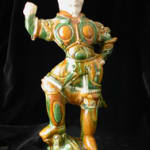Tang Sancai-Glazed Lokapala, 618 CE - 906 CE
Glazed Terracotta
16.5
H.982
Further images
Known as Lokapala and as the Devaraja, or Celestial King, this style of guardian figure is a more general type of Chinese art known as mingqi. Mingqi were any of...
Known as Lokapala and as the Devaraja, or Celestial King, this style of guardian figure is a more general type of Chinese art known as mingqi. Mingqi were any of a variety of objects specifically created for interment in the tombs of elite individuals in order to provide for the afterlife. These guardians were most likely interred in order to ward off potential tomb robbers or perhaps evil spirits in the next world that might try to infiltrate the tomb. Traditionally, this fierce, armored guardian stands, as represented here, upon a recumbent ox, with one foot resting on the head and another on the body, symbolic of the Celestial King’s authority. Originally, this type of figure had its origins in Buddhist philosophy; however, over the ages, as society became more secularized, they began to fulfill the more generic role of tomb guardians. As society evolved, these figures lost their religious significance and became symbolic of the military might that protected the wealth of the Tang from the nomadic barbarian invaders of the North. Clearly, these are imposing figures that were supposed to ward away the forces of evil and protect the deceased throughout eternity. The body armor of this Lokapala has been decorated with a gorgeous sancai, or three colored, glaze. This type of glaze originated during the Tang Dynasty and sancai-glazed pieces remain among the most popular works of Chinese art. Although these works were never meant to be viewed by the living, they amaze us with their refined artistry and sophisticated beauty. While this Celestial King is supposed to frighten us with his stern glare and aggressive posture, we are instead drawn to his overwhelming beauty and history.









